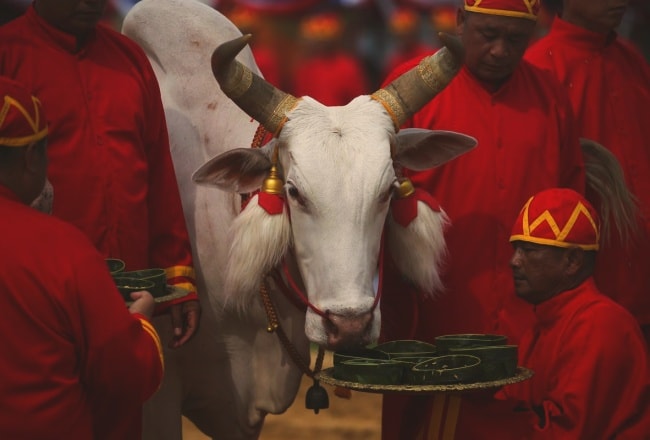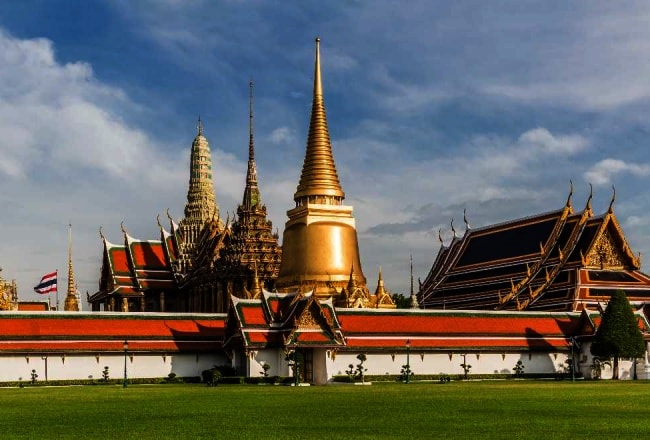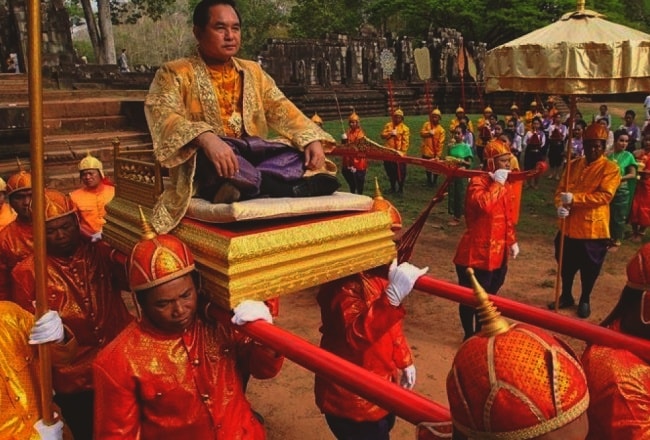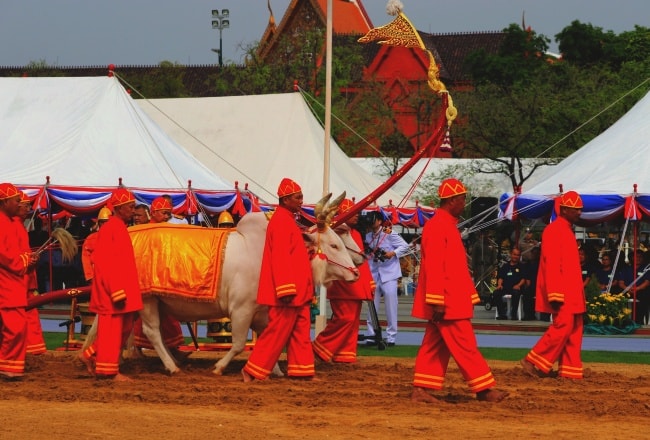In the various versions of Ramayana, Sita, the heroine appears from the ploughed earth as a baby when Janaka, the king of Videha ploughs the field in the royal ceremony. This is the earliest historical account of this agricultural ritual.
The Royal Ploughing Ceremony is an ancient royal tradition observed in Cambodia, Myanmar and Thailand to mark the traditional beginning of the rice growing season.
The tradition has Hindu and Buddhist origins and is intended to honour farmers and bless the plants and ceremonial start to the new growing season.
In the ceremony, Oxen are covered in red and gold and circle the ceremonial ground nine times, as a nine is a lucky and auspicious number in Thailand.
There are 16 million rice workers in Thailand and Thailand is the second largest exporter of rice in the world, underlining the importance of a good rice growing season to the country's economy.

Thailand
In Thailand, the ploughing ceremony dates back to the Sukhothai Kingdom (1238–1438). According to Quaritch Wales, a former adviser to King Rama VI and Rama VII of Siam (1924-1928), in his book Siamese State Ceremonies, the Thai adopted the Ploughing Ceremony in toto from the Khmers when they obtained the freedom from Khmer Empire upon the Independence of Sukhodaya in mid-13th century.
During John Crawfurd's Siam mission, he noted on 27 April 1822 (near the end of the reign of Rama II)
This was a day of some celebrity in the Siamese calendar, being that on which the kings of Siam, in former times, were wont to hold the plough, like the Emperors of China, wither as a religious ceremony, or as an example of agricultural industry to their subjects.
This rite has long fallen into disuse, and given place to one which, to say the least of it, is of less dignity... A Siamese...who had often witnessed it, gave me the following description:

A person is chosen for this occasion to represent the King. This monarch of a day is known by the name of Piya-Pun-li-teb, or King of the Husbandmen. He stands in the midst of a rice-field, on one foot only, it being incumbent on him to continue in this uneasy attitude during the time that a common peasant takes in ploughing once around him in a circle. Dropping the other foot, until the circle is completed, is looked upon as a most unlucky omen; and the penalty to the "King of the Husbandmen" is said to be not only the loss of his ephemeral dignity, but also of his permanent rank, whatever that may be, with what is more serious - the confiscation of his property. The nominal authority of this person lasts from morning to night. During the whole of this day the shops are shut; nothing is allowed to be bought or sold; and whatever is disposed of, in contravention of the interdict, is forfeited, and becomes the perquisite of the King of the Husbandmen following the ploughing. Specimens of all the principal fruits of the earth are collected together in a field, and an ox is turned loose amongst them, and the particular product which he selects to feed upon, is, on the authority of this experiment, to be considered as the scarcest fruit of the ensuing season, and therefore entitled to the especial care of the husbandman.

In Thailand, the common name of the ceremony is Raek Na Khwan, which literally means the "auspicious beginning of the rice growing season". The royal ceremony is called Phra Ratcha Phithi Charot Phra Nangkhan Raek Na Khwan, which literally means the "royal ploughing ceremony marking the auspicious beginning of the rice growing season". This Raek Na Khwan ceremony is of Hindu origin. Thailand also observes another Buddhist ceremony called Phuetcha Mongkhon which literally means "prosperity for plantation". The royal ceremony is called Phra Ratcha Phithi Phuetcha Mongkhon. The official translation of Phuetcha Mongkhon is "Harvest Festival".
King Mongkut combined both the Buddhist and Hindu ceremonies into a single royal ceremony called Phra Ratcha Phithi Phuetcha Mongkhon Charot Phra Nangkhan Raek Na Khwan. The Buddhist part is conducted in the Grand Palace first and is followed by the Hindu part held at Sanam Luang, Bangkok.
Series 2 banknotes first issued in 1925 during the reign of Rama VI and continuing into the reign of Rama VII depicted the Royal Ploughing Ceremony on the backs of all six denominations. Rama VII discontinued the practice in the 1920s, to be revived in 1960 by Rama IX, King Bhumibol Adulyadej.

In both Cambodia and Thailand, the ceremony is typically presided over by the monarch, or an appointee. Sometimes the monarch himself has taken part in the ceremony and actually guided the plough behind the oxen.
At present, the day on which Phra Ratcha Phithi Phuetcha Mongkhon Charot Phra Nangkhan Raek Na Khwan is held is called Phuetcha Mongkhon Day (Wan Phuetcha Mongkhon). It has been a public holiday since 1957.
In recent years in Thailand, King Vajiralongkorn has presided over the ceremony, which is held at Sanam Luang in Bangkok. Rice grown on the Chitralada Royal Villa grounds, home of the late King Bhumibol Adulyadej is sown in the ceremony, and afterward, onlookers swarm the field to gather the seed, which is believed to be auspicious

Cambodia
This ceremony has been celebrated for a number of centuries after it was initiated by a Khmer king who was greatly concerned with farming conditions and the people. Traditionally held in May (also known as Pisak), this ceremony marks the beginning of the rainy season. The rainy season was when the Khmer people began preparations for their farming activities according to the Satra, a book of governing traditional rules. Part of the purpose for the ceremony was also to hold prayer for a bountiful harvest. This ceremony is therefore held every year.
The ceremony traditionally begins with a feast. The first day of the waning moon, a feast is conducted by the Brahmans until five days have passed. The King (or a person he has assigned in his place) then begins the ploughing with two bulls to symbolize the start of the season as well as a good harvest to his people. The ceremony utilizes three rounds with the plow to sow rice seeds, then water, rice, soybeans, sesame, corn, grass, and wine are placed before the seat of the king for the bulls to symbolize different predictions of the future depending on what the bulls choose to eat.
For example, wine will result in an increase of crime, water means there will be flooding, and grass foretells disease striking the animals. The Royal Ploughing Ceremony in Cambodia is a national holiday with its first practices tracing back to the 5th or 6th century.
The ploughing ceremony is now considered to be one of the most important Khmer royal ceremonies and performs annually in Cambodia. The 2020 Cambodian Royal Ploughing Ceremony was set to be held on May 10 and is postponed as a measure to prevent the spread of Covid-19 in the kingdom.

Myanmar
Burmese chronicles traditionally attribute the start of this rite to the late 500s CE during the Pagan dynasty, when it was performed by the kings Htuntaik, Htunpyit and Htunchit, all of whom bear the name 'htun' or 'plow.' However, this costly ritual did not occur annually nor was it performed by every monarch.
During this ritual, the king plowed a specifically designated field outside the royal palace called the ledawgyi with white oxen that were adorned with golden and silver, followed by princes and ministers, who took turns to ceremonially plow the fields.
While the plowing was undertaken, Brahmin priests offered prayers and offerings to the 15 Hindu deities, while a group of nat votaries and votaresses invoked the 37 chief nats (indigenous spirits).
The ploughing ceremony was a ritual to propitiate the rain god, Moe Khaung Kyawzwa in order to ensure a good harvest for the kingdom, and also a way for the king to present himself as a peasant king to the commoners.
In Myanmar, the ceremony was practiced until 1885 when the monarchy was abolished








 25/12/2025
25/12/2025


























Jolie LIEMMy name is Jolie, I am a Vietnamese girl growing up in the countryside of Hai Duong, northern Vietnam. Since a little girl, I was always dreaming of exploring the far-away lands, the unseen beauty spots of the world. My dream has been growing bigger and bigger day after day, and I do not miss a chance to make it real. After graduating from the univesity of language in Hanoi, I started the exploration with a travel agency and learning more about travel, especially responsible travel. I love experiencing the different cultures of the different lands and sharing my dream with the whole world. Hope that you love it too!